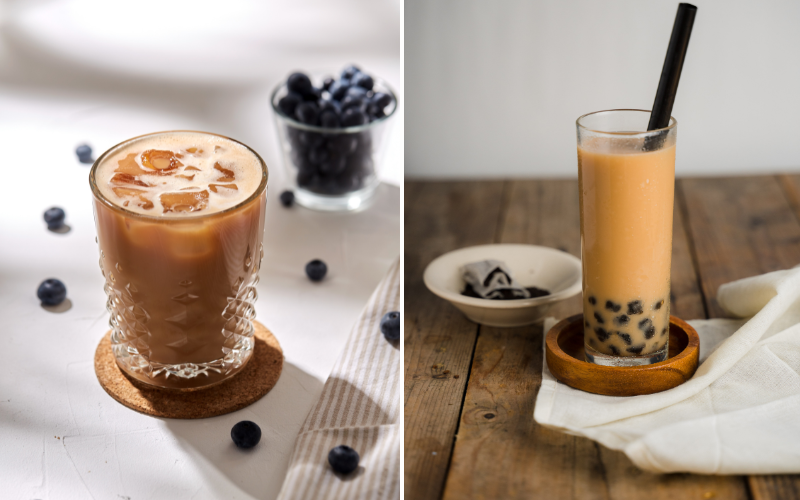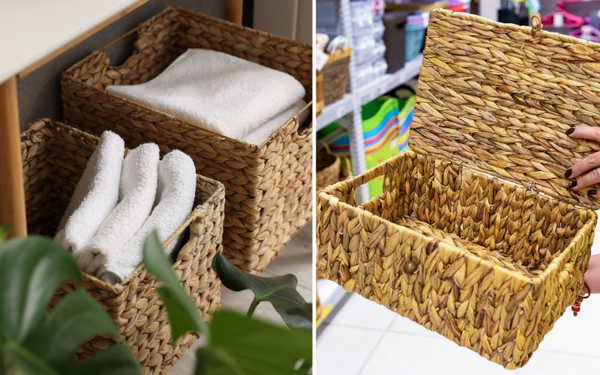If you own leather coasters, you know they add a touch of sophistication to your home. Yet, how do you take care of leather coasters to ensure this sophistication lasts? From the right way to clean and address spills to proper conditioning and storage tips, our article cuts through the fluff, diving into the specifics of leather coaster care and maintenance.
Key Takeaways
- Leather coasters require regular maintenance including daily wiping after use, periodic conditioning with appropriate oils or conditioners, and immediate attention to spills and stains using suitable methods to extend their life and preserve surfaces they protect.
- The longevity and maintenance needs of leather coasters vary based on the type of leather; full grain leather is more durable and develops a natural patina over time, while top grain leather may require more frequent care to maintain its refined appearance.
- Proper storage and protection of leather coasters are crucial for longevity, including keeping them in cool, dry conditions, away from extreme temperatures, and conditioned prior to prolonged storage to prevent drying out.
Understanding Leather Coaster Maintenance
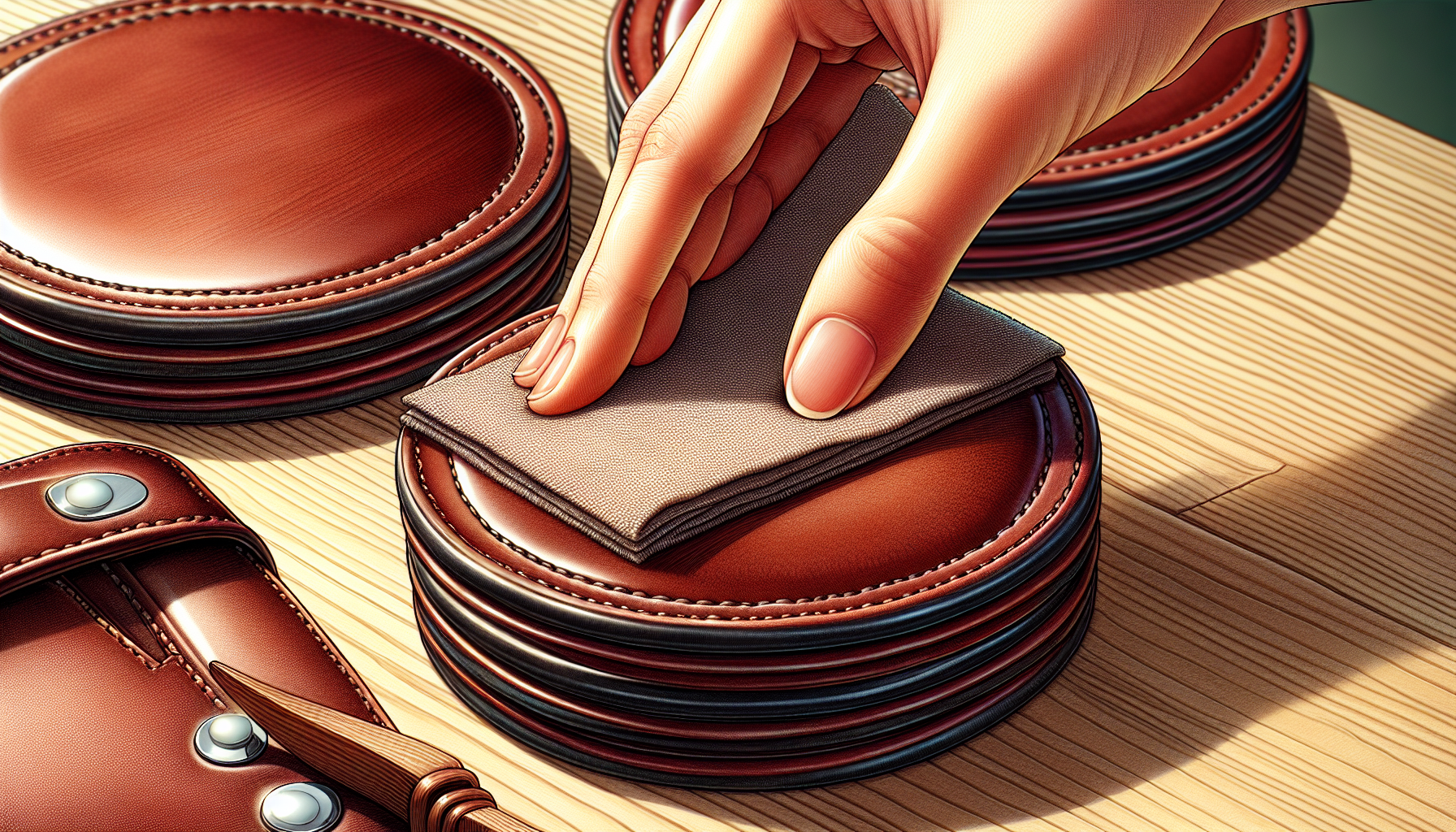
Leather coasters are a stylish yet practical accessory that can enhance the aesthetics of your table setting while protecting surfaces from stains and scratches. Therefore, understanding how to maintain them is crucial to extend both their life and the surfaces they protect.
One important thing to note is to avoid using wax or wax-based products on your coasters. These substances can clog the pores of the leather, hindering breathability and potentially leading to rot or dryness under the wax layer.
Daily Care Routine
Daily care for your leather coasters is relatively simple. Wiping them after each use is crucial to maintaining healthy leather and preventing damage. This can be done with a damp cloth to remove any spills or stains, ensuring you avoid harsh chemicals that could damage the leather.
Keeping up with this routine will prevent the build-up of stains and maintain the quality of the leather over time.
Conditioning Your Coasters

In addition to daily cleaning, it’s also important to condition your leather coasters periodically. Using a leather conditioner or cream helps maintain the quality of the coasters. The conditioner replenishes the natural oils and prevents the leather from drying out and becoming brittle. Even a small amount of conditioner can contribute to maintaining the longevity and suppleness of the coasters.
Natural oils like mink oil, coconut oil, or olive oil can be used in small amounts as a conditioner to help moisturize and nourish the leather.
Dealing with Spills and Stains
Despite our best efforts, spills and stains can occur. The key is to address them promptly to prevent them from settling and causing damage. Depending on the type of stain, different methods can be used. For unfinished aniline-dyed leather coasters, use the following methods:
- Tampico brush for general cleaning
- Damp sponge or cloth for water stains
- Cornstarch for grease stains
- Rubbing alcohol for ink stains
After cleaning, always remember to dry and condition the coasters.
For heavily soiled areas, apply a specially formulated leather cleaner with a lint-free cloth and massage gently before drying. Avoid using harsh soaps, baby wipes, strong chemicals, or water to prevent discoloration and spreading of stains.
The Role of Leather Quality in Maintenance

The quality of the leather used in your coasters plays a significant role in how you maintain them. Full grain and top grain are two distinct grades of leather, each with differing characteristics, that are commonly used in making leather coasters.
Full grain leather retains the natural grain from the top layer of the hide, which makes it more susceptible to stains. Therefore, it requires careful maintenance, such as regular conditioning, to protect against stains. On the other hand, top grain leather, which has its outermost layer removed, is thinner than full grain leather. Its refined surface may require slightly different care processes.
Understanding how leather quality influences maintenance is vital to preserving the longevity and appearance of your leather coasters.
Full Grain vs. Top Grain
Full grain leather, which retains the strongest fibers of the hide, is inherently more durable than top grain leather. The process of sanding away the natural grain in top grain leather removes some of the strongest fibers, making it more prone to noticeable scratching. However, the natural grain of full grain leather can exhibit unique imperfections and marks that contribute to its character without compromising its durability.
When choosing between full grain and top grain leather coasters, it’s important to consider the following:
- Full grain leather has a natural grain that is not sanded away, making it more durable and resistant to wear and tear.
- Top grain leather has an imitation grain imprinted on it after the natural grain is sanded away, giving it a more uniform look.
- Full grain leather requires minimal care to maintain its appearance, while top grain leather may require more care to keep it looking its best.
Consider your priorities for durability and maintenance when making your decision, taking into account your specific needs, such as using a product like sno seal.
Recognizing Unique Patina Development
As leather ages, it develops a unique patina, which is a soft sheen that forms on the surface of the leather. This patina enhances the beauty of the leather over time. Full grain leather, in particular, is known for developing a beautiful patina. On the other hand, top grain leather has a finishing coat that inhibits the development of a natural patina.
The development of patina can range from 6 months to several years, and it varies based on the type of leather and its usage. Patina develops through regular use and exposure to:
- light
- body oils
- moisture
- heat
These factors affect the leather’s appearance over time. A well-maintained patina shows evenness, suppleness, and fewer signs of cracking or damage, indicating the quality of the leather.
Long-Term Preservation Strategies
In addition to regular cleaning and conditioning, there are other strategies you can employ to ensure the long-term preservation of your leather coasters. Regular cleaning helps maintain their condition and appearance over time. In addition, conditioning your coasters every six to twelve months ensures the leather remains soft and nourished.
Caring for your coasters also includes proper storage to prevent warping and moisture damage, and careful handling to preserve the integrity of the material.
Storing Leather Coasters Properly
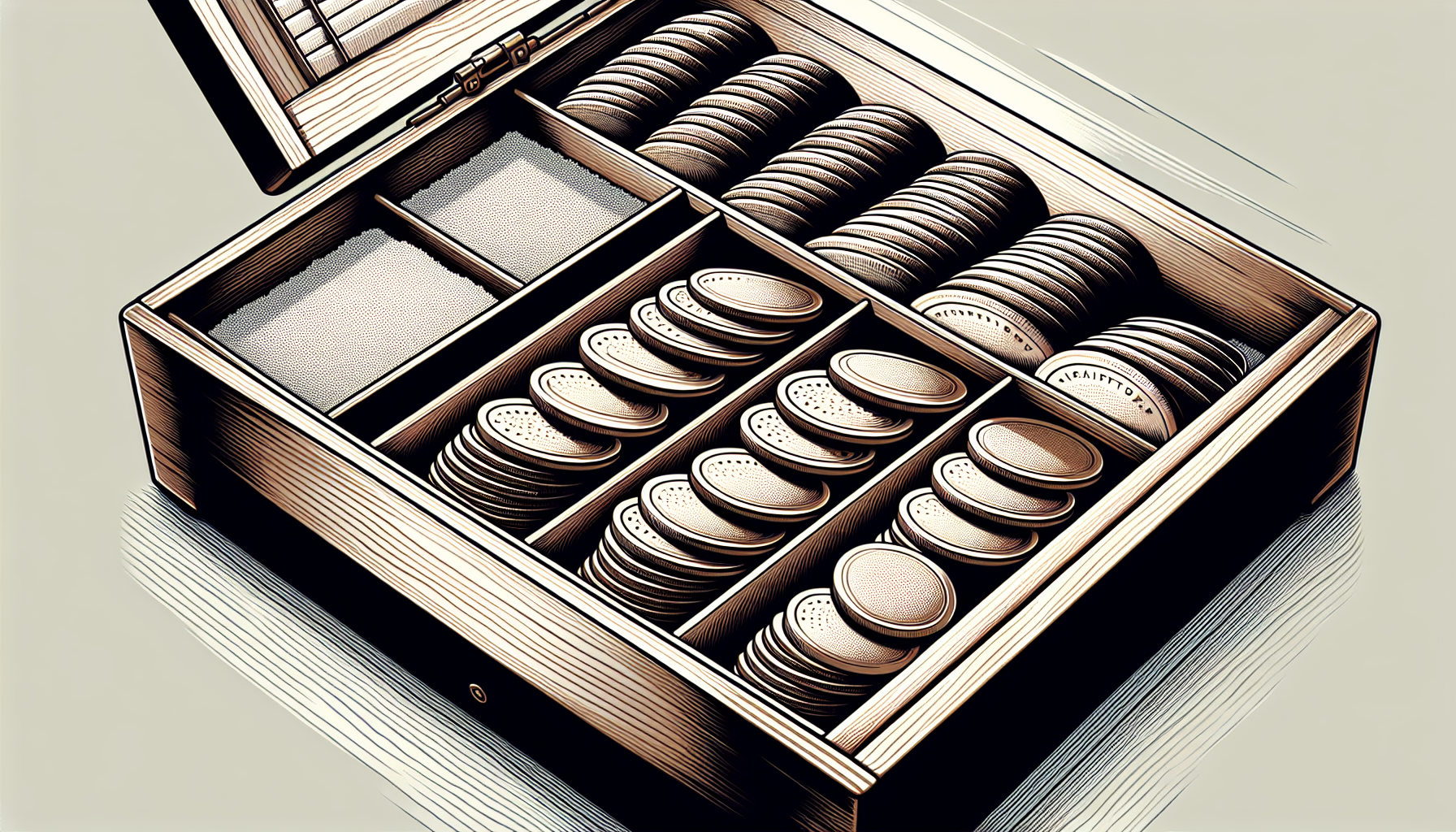
Storing your leather coasters properly can significantly extend their longevity. Here are some tips to keep in mind:
- Avoid storing them in plastic bags or containers that can trap moisture and lead to mold growth. Instead, opt for breathable dust bags.
- Leather is not fully waterproof, so coasters should not be exposed to water for prolonged periods.
- If your coasters become dry, rehydrate them, but ensure they are completely dry before storing to prevent future dehydration or damage.
By following these guidelines, you can ensure that your leather coasters stay in good condition for a long time.
To properly store your coasters, follow these guidelines:
- Store them in a cool, low-light space with around 50% humidity to prevent mold and warping.
- Be mindful of how you store your coasters. They should be stored flat, grain side down, or loosely rolled and wrapped in dark paper to prevent damage.
- Avoid storing coasters that are touching each other, particularly if they are colored, oiled, or waxed, to prevent color transfer and adverse reactions.
By following these storage tips, you can ensure that your coasters stay in good condition for a long time, ready to protect your surfaces from cold drinks.
Lastly, here are some tips for maintaining your coasters:
- Never fold your coasters, as this can lead to creases
- Keep them away from concrete and metal to avoid moisture loss and chemical reactions
- Perform a light dust or wipe-down weekly or as needed to maintain cleanliness before storing.
Protecting from Extreme Temperatures
Just like our skin, leather doesn’t react well to extreme temperatures. Your leather coasters should be stored in a temperature-controlled area that is cool and dry to prevent damage to the texture and structure of the leather. Don’t leave them exposed to the sun for extended periods, as heat and sunlight can deteriorate the leather’s quality.
If your coasters are not going to be used for a while, it’s essential to condition them to maintain their flexibility and prevent them from drying out.
Stylish Yet Functional: Balancing Aesthetics and Protection
While ensuring the longevity of your leather coasters is of utmost importance, you shouldn’t have to compromise on style. Regular cleaning is essential not only for maintaining the coaster’s functionality but also for preserving its aesthetic appearance. Applying a small amount of leather conditioner to clean coasters can keep them supple and prevent damage from condensation.
After all, it’s often the small details, such as coasters, that make a significant impact in interior design. They can add a touch of flair while preserving the beauty of your furniture.
Choosing the Right Finish
The finish or sealer you choose for your leather coasters plays a pivotal role in enhancing their longevity and appearance. After the edges of the coasters are smoothed out, a leather finish or sealer should be applied for additional protection. There are different types of finishes and sealers available, each offering varying degrees of protection and aesthetic appeal. Some popular options include:
- Leather wax
- Leather conditioner
- Leather dye
- Leather varnish
- Leather oil
Consider the specific needs of your leather coasters and choose a finish or sealer that best suits your preferences and requirements.
Regular maintenance of the coaster’s finish can prevent wear and tear, maintaining their quality over time.
Incorporating Leather Coasters into Table Setting
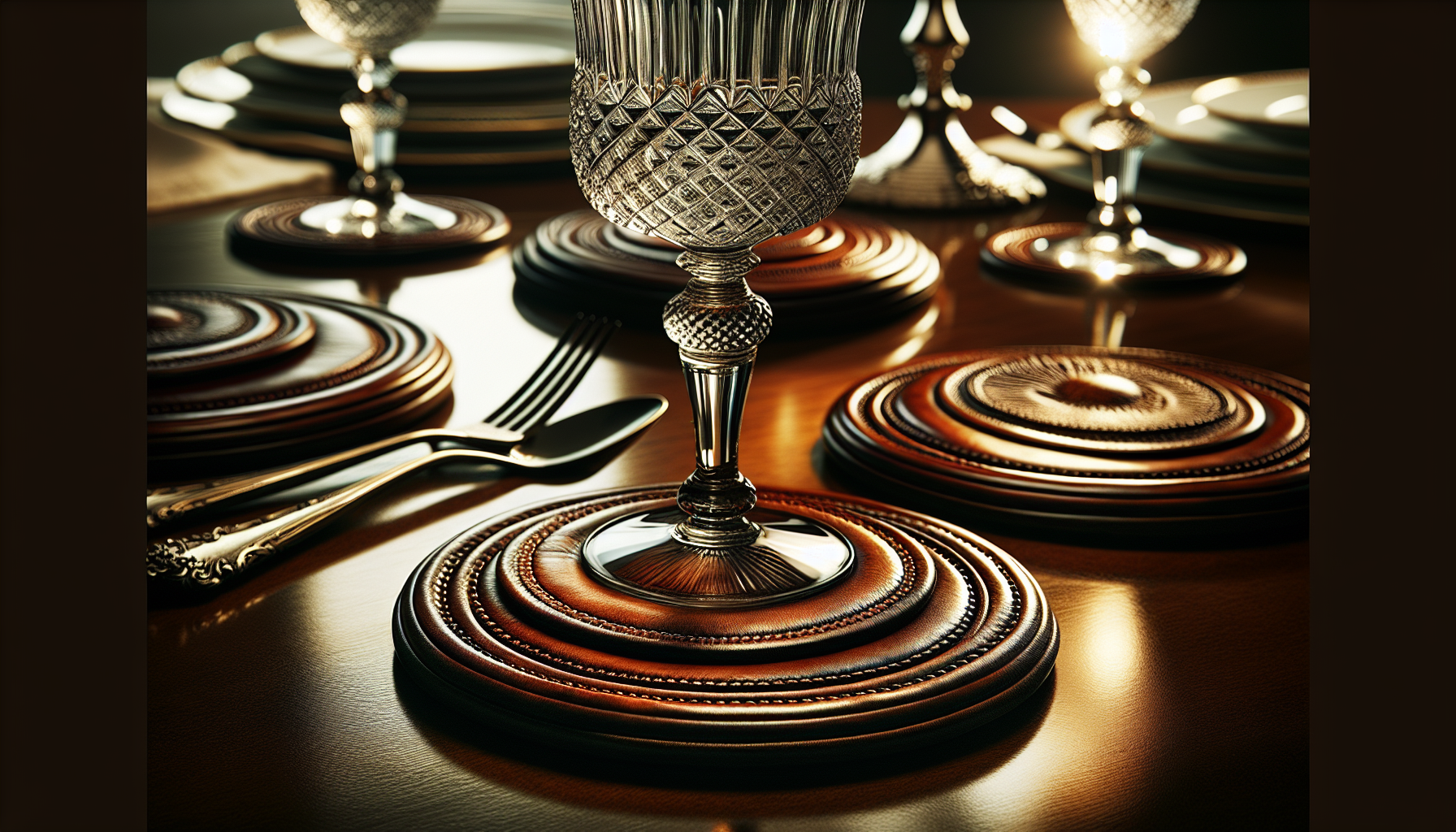
Not only are leather coasters functional, but they can also add a stylish touch to your table setting. Some benefits of using leather coasters include:
- Protecting surfaces from water rings and heat damage
- Adding a touch of elegance to your table decor
- Custom text imprints on leather coasters, such as event names or special dates, can add a personal touch to your table settings while ensuring the coasters are practical for protecting surfaces.
Addressing Common Concerns with Leather Coasters
Despite regular care, concerns with leather coasters can arise. It’s important to know how to address these concerns to prevent lasting damage. Here are some tips:
- If stains occur on your coasters, blot them immediately with a clean, dry cloth to prevent them from setting.
- If the stain persists, use a mixture of water and mild soap to gently clean the leather without causing damage, and always finish by drying the coaster completely.
- For resistant stains, a specialized leather cleaner may be necessary.
By following these tips, you can keep your leather coasters in great condition.
When to Opt for Professional Care
While most care and maintenance can be done at home, there are instances when professional care may be needed. For example, when dealing with deep-set or significant wear and stains, seeking professional help is advised. If your coasters have severe dehydration, professional assistance can ensure proper treatment.
If homemade or over-the-counter remedies are ineffective, consulting an expert or restoration specialist is recommended.
DIY Tips for Leather Coaster Care
If you prefer to take matters into your own hands, there are some DIY care and maintenance tips you can follow. To clean your coasters, use distilled water and a mild, natural soap, and avoid harsh chemicals that can damage the leather.
Homemade Leather Conditioner Recipes
One of the DIY care tips you can try is making your own leather conditioner. A homemade leather conditioner can be made from beeswax, cocoa butter, and sweet almond oil with a 1:1:2 ratio. You can adjust the consistency of the conditioner by modifying the ratio of beeswax and carnauba wax. More wax will result in a firmer product, and more oil will result in a softer one.
You can prepare the conditioner by melting the ingredients, pouring them into a container, and allowing the mixture to cool and solidify. Larger batches can be made by proportionally scaling up the ingredients. These natural waxes and oils help replenish the leather’s natural oils that may have evaporated, keeping the leather coasters supple over time.
The Do's and Don'ts of DIY Leather Care
When it comes to DIY care, there are a few do’s and don’ts to keep in mind:
- Always condition the leather using a high-quality leather conditioner, applied with a lint-free cloth in a thin, even layer.
- Avoid squirting conditioner directly on the leather.
- When preparing homemade leather conditioner, maintain low heat and constant stirring to prevent ingredients like beeswax and cocoa butter from burning.
Always ensure the leather is completely dry after cleaning before applying any conditioner. Lastly, perform a small test batch of the leather conditioner on a discreet area to check for desired results before fully conditioning the coasters.
Accessorizing with Leather Coasters: More Than Just Function
Leather coasters aren’t just practical – they can also serve as a stylish accessory. They can be a subtle yet powerful element of a dining experience, adding sophistication to the ambiance of both casual and formal gatherings. They can be seen as a part of the dining symphony, integrating with the clinking of glasses and the conversation, enhancing the overall elegance of the setting.
Leather coasters not only provide protection for surfaces but also serve as a testament to meticulous craftsmanship and natural beauty, contributing to the aesthetic appeal of the table. Leather goods with patina can still be functional and stylish, as the patina helps protect the leather from wear and tear.
Matching Coasters with Other Leather Accessories
There’s something visually pleasing about a cohesive look. Selecting leather goods like journals and bags with textures similar to your leather coasters will create a harmonious and refined look. Coordinating the color of your leather coasters with other items, such as placemats and furniture, can enhance the room’s decor and create visual consistency.
Ensuring that the finish on all of your leather goods, from coasters to bags, is consistent, whether it’s a matte or shiny effect, will establish a cohesive style throughout your space.
Creating a Cohesive Look
Creating a cohesive look goes beyond matching your leather coasters with other leather accessories. Choosing leather coasters with design elements that tie into the overall decor can complement interior design and reflect personal style. Leather coasters come in various designs that cater to different budget ranges, ensuring that there are styles to match any interior, from casual to elegant.
Selecting a color scheme for leather coasters that matches the official colors of a business or product can foster a cohesive branding environment while also complementing personal aesthetics. Coasters can be vibrant, textured, and stylish, fitting seamlessly with the overall aesthetic of a space, such as integrating with natural wood and white marble in modern eclectic styles.
Summary
In conclusion, proper care and maintenance of your leather coasters are crucial to preserve their longevity and aesthetic appeal. From understanding the importance of regular cleaning and conditioning to recognizing the role of leather quality in maintenance, implementing long-term preservation strategies, and balancing aesthetics and protection, these tips can help ensure your leather coasters remain stylish and functional over time. With the right care, your leather coasters can continue to add a touch of elegance to your table settings while protecting your furniture for years to come.
Frequently Asked Questions
How does a leather coaster work?
A leather coaster works by absorbing moisture, preventing it from spilling over onto the table while also not becoming oversaturated with liquid. This allows it to effectively protect the surface from condensation without soaking all the way through.
Do leather coasters last?
Yes, leather coasters last a long time and are a cost-effective solution for protecting your furniture.
Do you seal leather coasters?
Yes, it's important to apply a leather finish or sealer to protect the coasters from spills and stains. Be sure to allow the finish to dry according to the product instructions.
How do you treat leather coasters?
To treat leather coasters, wipe them with a damp cloth after each use and let them air dry, and use a leather conditioner occasionally to prevent cracking and fading. Regular maintenance helps to keep them in good condition for a long time.
How often should I clean my leather coasters?
You should wipe your leather coasters after each use to maintain their quality and prevent stains.
You Might Also Like...
